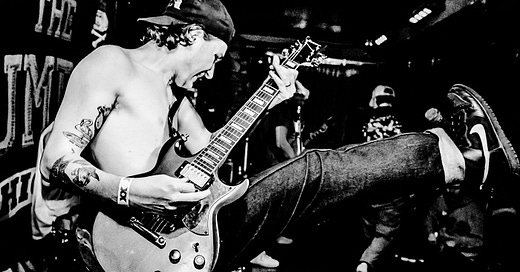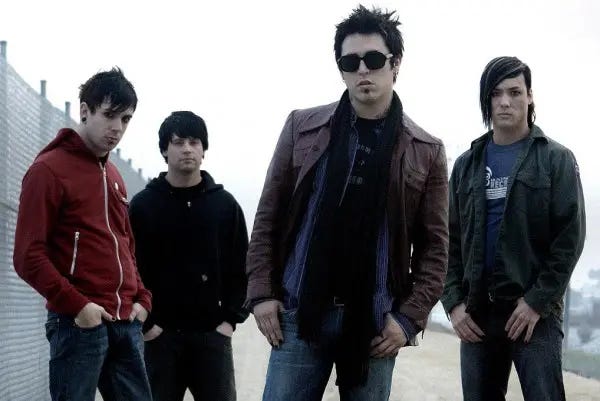LIFE’S QUESTION COURTESY OF KYLE BERGFORS
I just listened to the new Life’s Question EP for a second time. You’ll have to wait for April’s review roundup to get my full thoughts on it, but one thing is for certain — this is not your older brother’s hardcore. Sure, it owes a lot to Trapped Under Ice, but Life’s Question take the melodic elements from Big Kiss Goodnight and stretch them to — or even beyond — their logical limits.
The sing-scream dichotomy that slowly morphed turn-of-the-century metalcore into the realm of girl jeans and cartoon monster merch is back. This time it’s coming from more of an alt-rock direction. Some of the clean sung parts on this Life’s Question record sound straight out of shoegaze songs. The band are far from being the first modern hardcore act to tread down the sing/scream path either. Scowl, Regulate and Never Ending Game are just a few examples of artists whose last records flirted with (or totally embraced) a bit of non-traditional melody. Hell, Life’s Question did it on their last release too, as far as I can remember.
Something about their new stuff feels different, though. It might be the context of where the scene is at, or the fact that clean sung hardcore choruses are starting to become more of a pattern than a trend. Whatever the case, when LQ hit the singing part on EP opener “Light Me Up”, I picture a room full of people spraying Monster Energy Drink on each other while inflatable pool floaties sail over their heads.
Contrast that with the rooms I’m more comfortable in — where bands play on the floor and can’t hear their own instruments — or the super violent, no regard for human life approach of beatdown-infused metallic shit, and to me, it feels like we’re living in separate worlds.
I hate to keep harping on the post-pandemic boom, but it really is a cultural flashpoint for hardcore. Coming back to shows in late 2021, it felt like there were no boundaries and nothing was off-limits. The influx of fresh blood, coupled with the unprecedented and relatively unchallenged success of Turnstile’s alt-rock infused break-out Glow On, made it seem like everything had potential for anyone to find it cool. Even until last year’s festival season — where I saw Gag and Pain of Truth on the same day at Tied Down — hardcore seemed like it had moved beyond the petty tribalism that plagued it pre-pandemic.
That energy, at least from where I’m sitting, has changed. Big bands like Drain, NEG and Sunami might be drawing multiple hundreds of people in every town, but I don’t know where all these folks are coming from. The same 30 faces you see at every local show aren’t rolling up en masse to watch these big bands play. Not like they did a couple years ago. Those kids are all listening to either The Rival Mob or Everybody Gets Hurt and wouldn’t admit to liking any Turnstile record past the 7”s if you put a gun to their mother’s head.
Big HardcoreTM has captured an audience that feels almost divorced from what’s happening at your average DIY spot or small bar. You can hear it in the music, too. While hardcore’s upper-middle class are reaching for pop choruses and crossover appeal, most of the kids I know in local and regional bands are making their music harder, faster, or more obscure.
This chasm between art, intention and audience reminds me of the early 2000’s. I wonder what someone who was spinning the Tear It Up/Fast Times split in 2002 thought about the clean-sung parts on Vanity by Eighteen Visions. Sure, both of those things were ostensibly considered hardcore at the time. Still, almost everything about them, from the music, to the audience, to the bands’ ethics, were completely different.
EIGHTEEN VISIONS COURTESY OF PUNKNEWS
As acts like 18V and Poison the Well veered further off the beaten path, they inspired kids who’d never heard a song by Minor Threat (a must-listen for hardcore fans at the time) to pick up guitars and start creating “-core” adjacent music. Bands like The Devil Wears Prada and A Day to Remember started cropping up a few years later.
I wasn’t around in 2005 to gauge the initial reception on that next wave of shit. Undeniably, though, with 20 years of hindsight, we can see it was distinct from the hardcore scene. I’m sure that fact will get retconned in five years when Eli Enis’ prediction comes true and Emmure headlines This is Hardcore, but I can confidently say that in 2011, the average ADTR fan couldn’t name you a Trapped Under Ice song for all the money in the world. Some people might try to rebuke this because they like both of those bands. You gotta keep in mind though, for every ADTR fan who found their way to hardcore, there’s probably five who didn’t.
Flash forward to hardcore 2024, where bands who sing are playing different rooms, with different ambitions, to different kids, than the not-as-big but equally vibrant and important revivalist or tough guy scenes. It feels like there’s an irreconcilable splinter between purist hardcore and this adventurous new wave.
It’s not as cut and dry as I’m making it out to be. Tough guy titans Pain of Truth are going on tour with A Day to Remember this Summer. I know plenty of youngsters who love both Life’s Question and whatever Scheme Records band us old people are jerking off over this week. You could also point to the fact that most of this shit just comes back into the same fold over time. I’m sure folks were having this conversation about Los Crudos and Earth Crisis in 1994, and you’d be foolish to deny either band canonical status.
Still, modern hardcore’s unprecedented popularity, combined with some bold new musical choices and a tacit rejection of old-school ethics makes me wonder if we’re setting the stage for the type of disconnect and subsequent outgrowth we saw 20 years ago. I don’t think there’s anything wrong with that. I just doubt I want to hear the results.






“ Sure, both of those things were ostensibly considered hardcore at the time.”
Ehhhhhhh